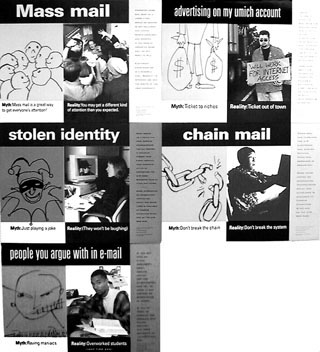The University Record, September 13, 1999 From the Office of the Chief Information Officer

In late August, many U-M community members received a mass e-mail message (spam) that provided a link to a Web site listing establishments licensed to serve alcohol in Michigan.
Many recipients were annoyed because:
The University’s User Advocate was able to quickly investigate the incident. It was found that the message did not originate from the U-M. The postmaster at the institution of the originating message and the person responsible for the mailing were immediately contacted and asked to stop such mailings to the University community.
Because of its open environment, the University can be the target of these spam messages. However, because it is difficult to know whether an e-mail message is legitimate or not, the U-M currently does not aggressively pursue blocking messages to members of the community.
E-mail is a powerful, useful and wide-reaching medium, and users often are tempted to exploit it. Sending mass e-mail messages, however, can violate U-M policies and the rights of others in the community.
Under a broad policy designed to ensure the sharing of ideas consistent with its academic missions, the U-M considers the content of e-mail messages to be the responsibility of the sender. It also, however, considers e-mail sent to more than one or two groups to be an inappropriate use of computing resources. Further, the community expects that mail sent to a group will be appropriate to the purposes of that group.
“An individual who puts together a list of e-mail groups may not realize the number of times this combined list might be used by others for other purposes,” explains Olivia Padilla, graduate student in the School of Public Policy who also has been an information technology user advocate with the Office of Policy Development and Education. “This can result in thousands of e-mail messages and can strain the University’s computing resources.”
Recipients generally interpret communication directed to their electronic mailbox as quite personal. It is not uncommon in such situations for someone to respond angrily, either to the content of the message or its intrusive nature. Unfortunately, the remoteness and speed of e-mail often entice individuals to communicate pointedly, perhaps even recklessly.
Once you have responded angrily and impulsively and pressed the “send” button, it can be difficult to explain your original behavior to the recipient and make amends. Further, your language, including phrasing, emotion and implications, may be subject to other interpretations, particularly when other cultures, attitudes or lifestyles are involved.
E-mail users need to practice “netiquette”—appropriate communication, as well as communication that is sensitive to the manner in which recipients might react to the message.
“Respect for community is embodied in behavior that shows sensitivity in communication,” Padilla notes. “Never send hurtful or harassing messages or images to others.”
Responsible use of computing resources
These tips are offered by Virginia Rezmierski, director of the Office of Policy Development and Education. Her office is headquarters for a team of individuals called user advocates that receives and investigates reports of potential abuses of U-M technology and violations of U-M policies. User advocates also provide policy interpretation and related information to help students, faculty and staff understand University and departmental policies and encourage responsible use of shared resources.
User advocates also work with staff from the Office of Student Affairs, Department of Public Safety and other units to ensure that information technology-related policies and guidelines are followed consistently across campus. They also meet four times per year with academic discipline officers and system administrators to discuss incidents and incident trends in U-M’s electronic environment.
User advocates can be reached at 647-4274 or by sending e-mail to [email protected]..

